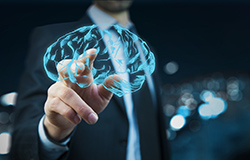A better understanding of brain health at our (bionic) fingertips
One of the main challenges for developers of artificial limbs is that of enabling users, such as amputees, to experience their functionality intuitively. This quest to develop prosthetics which offer almost natural motion and sensation has resulted in recent advances in the development of accompanying neurological interfaces, allowing feedback between the brain and sensors. The work incorporates diverse expertise including: cognitive science, brain imaging, cell biology and mechanics, tissue engineering, information processing, robotics and, medical rehabilitation. Two EU-funded projects have contributed directly to tackling the challenge, with their work continuing to yield research insights and technologies towards the endeavour. NANOBIOTOUCH, which closed in 2013, developed a human finger pad which was able to detect directional force and temperature, critical to realistic tactility. Building on this, researchers have since used nanoelectromechanical (NEMS) arrays, combined with neural network information processing, to allow artificial exploration of surfaces to be achieved in ways even closer to human haptic behaviour and affective response. NEBIAS, an ongoing project, is working on the creation of upper limb prosthesis controlled by a neural interface, enabling a stable and very selective connection with the nervous system. The project also seeks to achieve a better understanding of the ‘language’ that enables the central nervous system to communicate with peripheral nerve signals. It is doing so by investigating electromagnetic brain and nerve signals, as well as changes in brain's blood flow/metabolism related to movement. Understanding the neurophysiological response This wealth of research has generated fresh, and somewhat unexpected, insights into the ways in which the brain actually functions. Earlier this month the journal 'Drug Target Review' reported the fact that findings supported by research from the aforementioned projects, have offered new ways to ‘measure brain health.’ The journal reports one of the researchers, Henrik Jörntell from Lund University in Sweden as stating that, ‘We were able to measure the cooperation between neural networks in a very precise and detailed way. We can also see how the entire network changes when new information comes in.’ This recent study was able to emulate human touch sensations using a bionic fingertip designed for robotic upper limb neuroprostheses, with sensor nerves embedded in a rat’s skin receiving these artificial touch experiences. The team were able to get a better sense of how the brain perceives the external world through touch using a tool which enabled high-resolution analysis of how individual neurons and their connected brain networks process the incoming information. Amongst the discoveries, was the fact that individual neurons can convey much more information than was previously presumed and can actually interact, creating rich representations of sensory stimuli. Beyond biorobotics The Drug Target Review report quotes lead bioroboticist Calogero Oddo - a contributor the the NANOBIOTOUCH project - as saying that, ‘This knowledge will be embodied into a novel generation of sensitive robotic hands able to convey fine tactile information to amputees.’ Yet, in addition to increasing medical rehabilitation for amputees, sensitive artificial limbs could also be used to augment robotic abilities for intricate tasks requiring dexterity and precision, such as surgery or in some rescue operations. Additionally, the study findings related to how healthy neurological networks in the brain actually function has important implications beyond biorobotic applications. With progressive neurological diseases such as Parkinson’s and Alzheimer’s, these neurological networks alter in ways which have been hard to track effectively. A stroke for example, even when brain damage is localised, can cause the entire neural network to suffer. This study has contributed to neurological understanding by highlighting the fact that how the brain processes sensory impressions can actually indicate brain health as a whole. For more information please see: NEBIAS project website NANOBIOTOUCH CORDIS webpage
Countries
Italy, United Kingdom



